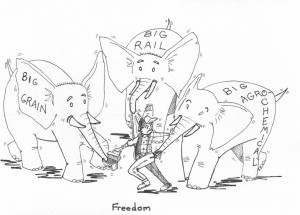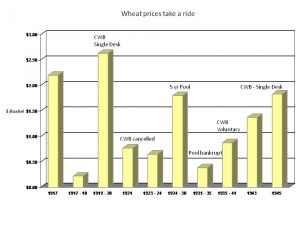 (February 28, 2017) One of the most well founded complaints from prairie grain farmers is about not getting fair weighing and grading of their grain by elevator companies. In fact 117 years ago this March the Senkler Royal Commission tabled its report documenting how prairie grain handling companies were exploiting farmers through price fixing, dishonest weights, and even more dishonest grades.
(February 28, 2017) One of the most well founded complaints from prairie grain farmers is about not getting fair weighing and grading of their grain by elevator companies. In fact 117 years ago this March the Senkler Royal Commission tabled its report documenting how prairie grain handling companies were exploiting farmers through price fixing, dishonest weights, and even more dishonest grades.
This Commission was part of how prairie farmers got the first pieces of legislation that would eventually lead to the Canadian Grain Commission with its mandate to enforce fairness in grading and weighing of grain.
But guess what? I and many others have been hearing complaints lately that demonstrate the grain elevator companies are behaving in ways that have a strong similarity to the findings of the Senkler Commission. With the end of the Canadian Wheat Board and the gutting of the Canadian Grain Commission by the Harper government we probably shouldn’t be surprised.
117 years ago the Senkler Commission observed: “the elevator owners have had it in their power to depress prices below what in our opinion farmers should realize for their grain. It would naturally be to their interest to so depress prices; and when buying, to dock as much as possible.”
The Commission found that farmers were baited into the elevator with promises of a high price for their first quality wheat and then switched to a lower payment either because it was claimed the grain was a poor quality, or the elevator had no room for number one wheat but did have room for a lower value grade. 117 years later we are hearing similar experiences from grain farmers across the prairies. Some things just never change.
The National Farmers Union is asking farmers for their experiences selling grain to elevators, mills, and other buyers. Instead of a Royal Commission holding meetings across Manitoba and the “North West Territories” as Alberta and Saskatchewan were then known, the NFU questionnaire will be mailed to NFU members and is available on-line so any farmer across Canada can put their information forward. The survey can be completed anonymously.
The NFU on-line survey also contains some useful gems of wisdom too many farmers may have forgotten. For example the law requires that any grain delivery contract between a farmer and a grain company must include provisions for a penalty to be paid to the farmer if the licensed grain company has not accepted the farmer’s grain (of the kind and grade of grain specified) during the delivery period defined in the contract.
It also contains a link to the Canadian Grain Commission web page explaining how to obtain a mandatory and binding grade on grain delivered to a licensed elevator. These provisions provide protection to farmers who use them.
The NFU will keep all individual responses confidential and aggregate the results for future publication. This is an opportunity for farmers to have their say and give the NFU and government current information on the behavior of the grain trade.
Get clicking here: NFU on-line survey



The chart on wheat prices would be much more effective if we could see the old prices in terms of 2017 dollars. What would a $2.20 bushel of wheat in 1917 look like today? What could you buy for $2.20 then? I might guess you could get a pretty significant bag of groceries. What about today? Maybe a chocolate bar?
I recently did some analysis on the value of $6 in 1973. Using inflation guidelines published by a well-known livestock association, that $6 is equivalent to over $30 today.
The prices that took a ride on your chart would look astounding if we could logically display them in terms of their buying power.
The world might like to see that.
Your calculation is pretty accurate Darrell. The Bank of Canada has an inflation calculator which shows that $2.20 in 1917 would be worth $38.50 today if it had kept up with inflation.
The graph shows the price of wheat FOB at port. It demonstrates the power of farmers bargaining collectively to take more of the world price.